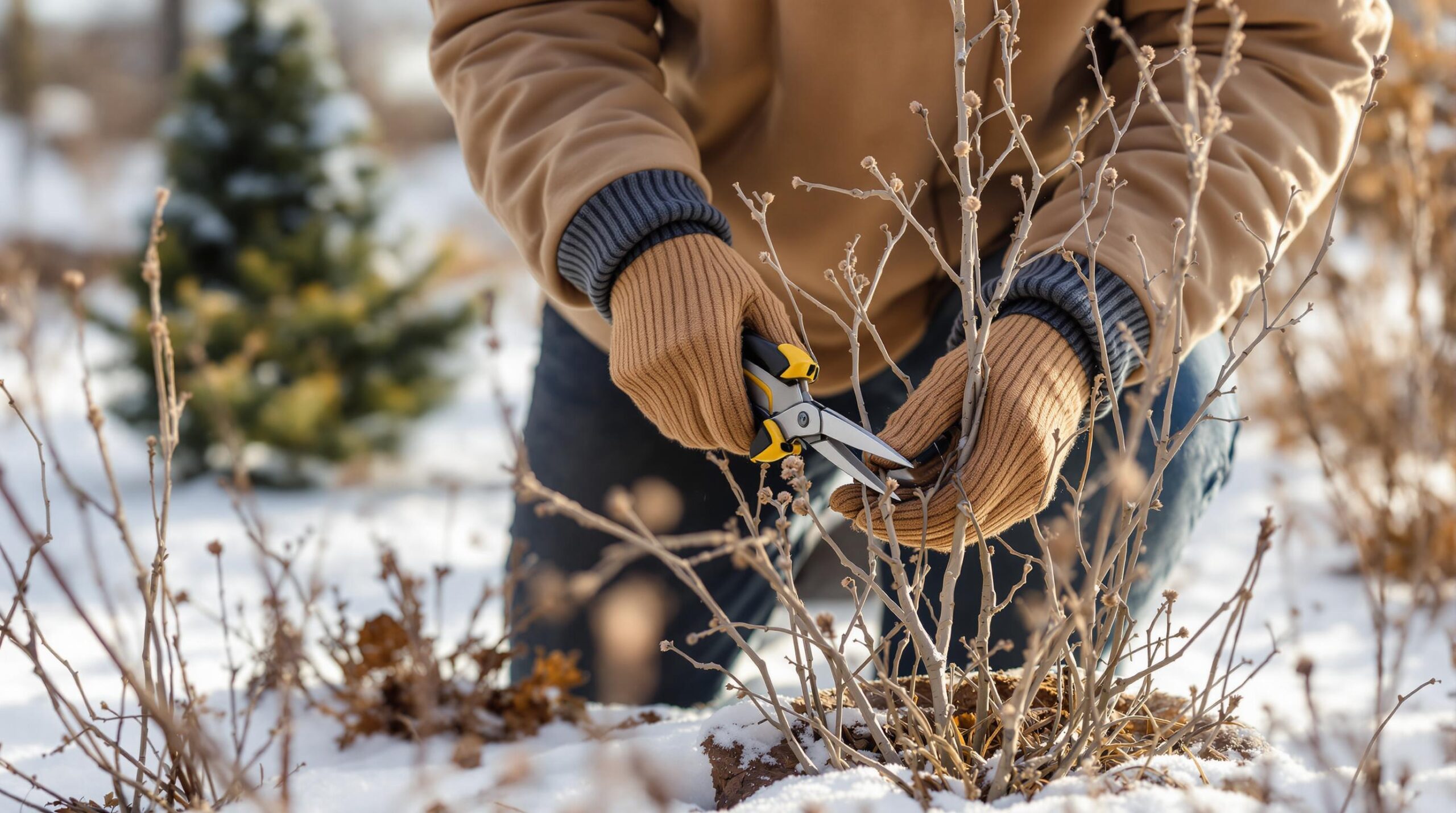- bhavya gada
- No Comments
The best time to prune dormant plants in Maryland is late January to early March. During this period, plants are in their dormant phase, making it easier to remove dead or damaged branches without stressing the plant. Prune on dry days when temperatures are above 32°F and no frost or precipitation is expected.
Key Points to Remember:
- What to Prune in Winter: Deciduous trees and shrubs (dead, damaged, or crossing branches).
- What to Avoid: Spring-flowering shrubs (they bloom on last year’s growth) and evergreens (wait until late spring or summer).
- Tools You’ll Need: Bypass pruners, loppers, pruning saw, safety gear, and clean, sharp tools.
- Correct Techniques: Cut at a 45° angle above an outward-facing bud, sanitize tools between cuts, and avoid removing more than 25% of live branches in one season.
Winter pruning ensures healthier plants and better spring growth while reducing the risk of disease and pests. Follow these tips or consult a professional for larger trees or complex pruning needs.
When to Prune in Maryland
Best Months for Pruning
The ideal time to prune deciduous trees and shrubs in Maryland is during their dormant phase, which falls between the end of the coldest winter weather and the start of spring bud growth. This window, typically from late January to early March, allows plants to focus their energy on healing cuts rather than supporting new growth. Pick a day within this timeframe when the weather is suitable.
Weather and Temperature Timing
Choose dry days with temperatures above 32°F, ensuring no precipitation is in the forecast and branches are free of frost. These conditions help wounds heal faster and lower the risk of disease.
PETITTI | How to Prune Dormant Trees in Late Winter and …

Which Plants to Prune in Winter
Some plants thrive with winter pruning, while others should wait. Timing is key – plan your pruning between January and March, keeping an eye on frost forecasts for the best results.
Plants You Can Prune in Winter
Winter is a great time to prune dormant deciduous trees and shrubs. With no leaves, it’s easier to spot and remove dead, damaged, or crossing branches. Plus, cuts made during dormancy heal faster, setting the stage for healthy spring growth.
Plants to Hold Off on Pruning
Skip pruning spring-flowering shrubs in winter. Their buds develop on last year’s growth, so trimming now could mean fewer blooms. Also, hold off on pruning evergreens – both conifers and broadleaf varieties – until late spring or early summer, after their new growth has matured.
sbb-itb-843f8be
Why Prune During Winter
Winter pruning helps plants thrive by removing dead or weak branches, reducing the risk of diseases and pests, and encouraging a strong branch structure. By cutting selectively, you direct the plant’s energy to fewer buds, which leads to bigger flowers and a more productive harvest come spring.
How to Prune Correctly
To get the most out of winter pruning, it’s important to use the right tools and follow proper techniques. This ensures your plants heal well and thrive come spring.
Tools and Equipment
Having the right tools makes pruning easier and more effective:
- Bypass pruners: Ideal for branches up to ½ inch thick.
- Loppers: Best for branches between ½ and 2 inches in diameter.
- Pruning saw: Designed for cutting limbs thicker than 2 inches.
- Safety gear: Protect yourself with leather gloves and safety glasses.
- Clean, sharp tools: Prevent spreading disease by maintaining your equipment.
Proper Cutting Methods
Using the correct cutting techniques is key to healthy growth:
- Make cuts at a 45-degree angle, about ¼ inch above an outward-facing bud.
- For branches thicker than 2 inches:
- Start with an undercut 12–18 inches from the trunk.
- Follow with a top cut slightly farther out.
- Finish by removing the stub at the branch collar.
- Use pruning sealant on cuts larger than 1 inch in diameter.
- Sanitize tools between cuts with an alcohol-based cleaner to reduce disease risk.
Common Pruning Mistakes
Avoid these errors to keep your trees and shrubs healthy:
- Don’t leave stubs – always cut at the branch collar.
- Never top trees; it weakens their structure and invites disease.
- Avoid pruning in freezing or wet conditions.
- Skip flush cuts against the trunk, which can damage the branch collar.
- Don’t remove more than 25% of live branches in a single season.
Next Steps
Once you’ve got the tools and techniques down, it’s time to decide: handle the job yourself or bring in the professionals.
- Opt for DIY if you’re dealing with small shrubs or straightforward trimming.
- For larger trees or more intricate pruning, consider hiring Pro Landscapes MD.
Pro Landscapes MD Services

Pro Landscapes MD offers winter pruning services across central Maryland. Their team of expert horticulturists provides:
- Detailed plant health assessments and customized pruning plans
- Precision cuts to encourage healthy growth in the spring
- Personalized maintenance schedules and free project estimates [1]
Reach out to Pro Landscapes MD today to book a winter pruning consultation and ensure your dormant plants are well cared for.
FAQs
How can I tell if a branch needs to be pruned during winter in Maryland?
To determine if a branch needs pruning, look for a few key signs. Branches that are dead, damaged, or diseased should be removed to maintain the health of the plant. Dead branches will often feel brittle, lack buds, or have peeling bark. Diseased branches may show discoloration, unusual growths, or signs of pests. Additionally, prune branches that are crossing or rubbing against each other, as this can cause damage over time.
Winter is an ideal time for pruning dormant plants in Maryland, as it minimizes stress on the plant and allows you to shape it before spring growth begins. If you’re unsure about how to proceed, consulting a professional like Pro Landscapes MD can ensure your plants are properly cared for and thrive year-round.
How can I know if I’m pruning my dormant plants correctly, and what are the signs of improper pruning?
To ensure you’re pruning dormant plants correctly, pay attention to the plant’s overall health and growth after pruning. Proper pruning promotes healthy regrowth, balanced shape, and improved flowering or fruiting in the next season. Signs of correct pruning include clean cuts just above growth nodes or buds, no torn or jagged branches, and no excessive removal of healthy wood.
On the other hand, improper pruning may result in visible damage, such as torn bark, uneven cuts, or over-pruning, which can stress the plant. Watch for signs like stunted growth, excessive suckering (small shoots growing from the base), or dieback of branches. If you’re unsure about your technique, consider consulting a professional landscaping service like Pro Landscapes MD, which offers expert pruning and plant care services tailored to Maryland’s climate.
Are there certain plants or trees I should avoid pruning during Maryland winters?
Yes, some plants and trees are more sensitive to winter pruning and should be handled with care. For example, spring-flowering shrubs like azaleas, lilacs, and forsythias should not be pruned in winter, as this can remove their buds and affect their spring blooms. Similarly, trees that are prone to bleeding, such as maples, birches, and elms, are best pruned in late summer or early fall to avoid excessive sap flow.
If you’re unsure about the right timing for pruning specific plants in your yard, consulting with a professional horticulturist can help ensure your landscape stays healthy and vibrant. Pro Landscapes MD offers expert garden and tree care services tailored to Maryland’s unique climate, helping you maintain the natural beauty of your property year-round.


















Chat with Us